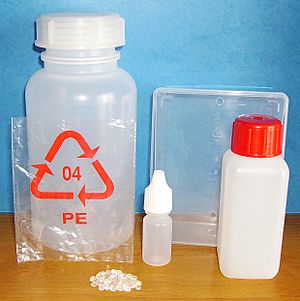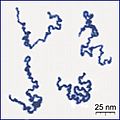Polymer facts for kids
A polymer is a very large molecule. Think of it like a long chain! This chain is made by linking together many smaller molecules. These small building blocks are called monomers. The word "polymer" comes from Greek words: "poly" means "many," and "mer" means "unit." So, a polymer is simply "many units" joined together. The special chemical reaction that connects monomers to make a polymer is called polymerization.
Some polymers are found in nature. Living things, like plants and animals, make them. For example, proteins are natural polymers. They are built from different amino acid units. Nucleic acids, like DNA, are also huge natural polymers. They are made of millions of tiny nucleotide units. Cellulose and starch are natural polymers too. They are found in plants and are made from sugar units. Even natural rubber is a mix of polymers! On the other hand, Plastics are examples of polymers made by people. Many fibers used in clothes are also made from polymers.
Contents
What are Polymers?
Polymers are everywhere around us. They are in our bodies, our clothes, and many things we use every day. Understanding polymers helps us learn how materials are made. It also shows us how living things work.
Different Kinds of Polymers
Polymers can be sorted into different types. This depends on what their building blocks (monomers) look like.
Homopolymers: Same Building Blocks
If all the small units (monomers) in a polymer chain are exactly the same, it's called a "homopolymer." We name homopolymers by adding "poly-" before the monomer's name. For example, if you link many styrene monomer molecules together, you get a polymer called polystyrene. Polystyrene is used to make things like foam cups and plastic cutlery.

Copolymers: Different Building Blocks
Sometimes, a polymer is made from two or more different types of monomers. When this happens, the polymer is called a "copolymer" or a "heteropolymer." Think of it like a necklace with different colored beads. These different units can give the polymer special properties.
How Polymers are Built
Many polymer molecules look like long chains. The monomer units are like the links in these chains. These chains can be arranged in different ways:
- Straight-chain: The monomers link up in a simple, straight line.
- Branching: The main chain has smaller chains sticking out from it, like branches on a tree.
- Cross-linking: Different polymer chains can connect to each other. This forms a strong network. Imagine ropes tied together to make a net. For example, in some proteins, two parts of the chain can link up using a special bond called a disulfide bridge. This helps hold the protein's shape.
See also
 In Spanish: Polímero para niños
In Spanish: Polímero para niños
Images for kids
-
Appearance of real linear polymer chains as recorded using an atomic force microscope on a surface, under liquid medium. Chain contour length for this polymer is ~204 nm; thickness is ~0.4 nm.
-
Microstructure of part of a DNA double helix biopolymer











